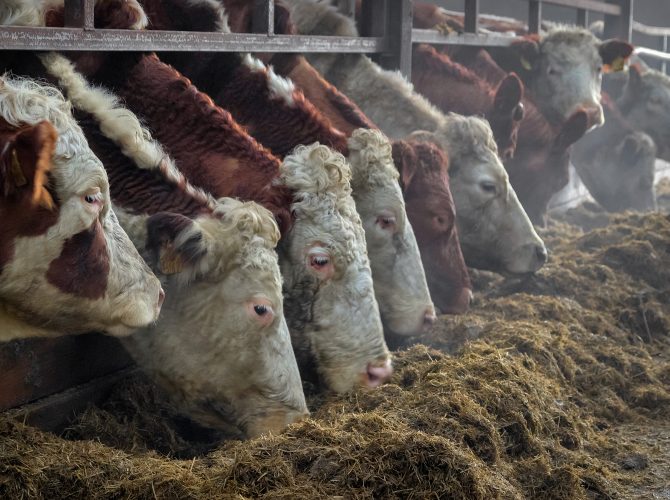Plan Carefully for Parasite Control at Housing
2nd September 2023

Dairy farmers have the ideal opportunity to control parasites over the winter period while cows are housed. Gut worms, lungworm, liver fluke, lice and mange mites can all have significant health, welfare and production impacts on cows while they are indoors, so it is important to understand both the challenges and treatment options available.
The best course of action, including product choice and dose timing, will vary from farm to farm and from year to year, depending on weather and management factors. Here, Matt Colston, a vet at Elanco Animal Health, provides some key pointers to help farmers plan the most effective parasite control for their herd this autumn.
Liver fluke
“The weather this spring and summer has been very different to last year, so we have to expect the liver fluke challenge to be different too. For many farms this may still be a low risk, but it pays to check as even a small number of liver fluke can have an impact on productivity in outwardly healthy-looking animals, including a negative effect on feed utilisation efficiency and milk production,” he says.
“Therefore, it’s vital to understand the fluke lifecycle and the influence the weather, ground conditions, grazing management and timing of housing can have on the fluke risk.”
Mr Colston recommends testing for liver fluke and monitoring the stage of parasite development in your herd, so you know the specific risk on your individual farm to help inform appropriate treatment choice and timing.
“It’s worth noting that none of the products currently available can kill all the fluke stages present at once, and treatments at the point of housing will always leave some fluke behind, so weighing up the risk and treatment timings is key to success,” he says.
“To get a full picture of the fluke risk on your farm, you’ll need to work with your vet to carry out testing. This will enable you to weigh up whether it’s best to treat cattle at the optimum time after housing and take the potential hit on performance before treatment or treat as soon as possible at housing to remove as many fluke as possible and limit negative impacts on production.
Mr Colston advises that in a year like this one, where the risk will vary hugely from farm to farm, the best option is to have a plan specific to your farm, based on monitoring the fluke challenge in your animals.
With this in mind, the test results should help inform which product is most suited to your herd. “For example, triclabendazole, given orally (for example Fasinex™ 240), will remove the majority of fluke when given 2 weeks after housing, while albendazole, oxyclosanide and clorsulon only kill adult fluke, so need a waiting time of 10-12 weeks after housing to remove the majority of the fluke present. In addition, triclabendazole and clorsulon can only be used in the dry period, and as the milk withdrawal period varies between individual products, this should always be checked before administration of dairy cows.”
It is however essential that where there is a risk of liver fluke infection on the farm, all cattle, including adults, should be treated for liver fluke in order to maintain productivity and welfare.
“After initial treatment, I’d recommend checking for any surviving adult fluke, or re-treating with an active to target any remaining adult fluke before turnout. This will limit the number of fluke eggs reaching the pasture and reduce the fluke risk for the following season,” says Mr Colston.
Gut worms and lungworms
While liver fluke may pose the greatest risk to cows, gut and lungworms can have major economic and welfare impacts, mostly in young stock.
Mr Colston explains that these worms can be effectively treated up to five weeks before cows are housed.
“Using an active such as doramectin, which has persistent activity, as a late grazing season treatment for lungworm will double-up as the housing treatment; it will remove any lungworm present and prevent re-infection before housing,” he says.
“The treatment should also be fully effective against gut worms, including inhibited stages of the round worm Ostertagia and should also prevent reinfection before housing, to eliminate the risk of type 2 Ostertagiasis later in the winter.”
Lice and mange
In order to avoid the welfare and productivity issues caused by ectoparasites over the winter, it is also essential to consider treatment for lice and mange at housing.
Both parasites can survive away from host animals in the shed environment, so it is imperative that all animals are treated effectively to avoid re-infection while stock is housed. Any animals added to the group during the housing period also need to be treated.
“For young stock, where worms are also a concern, look for a pour-on endectocide, such as Dectomax™ Pour On, as this will treat all three types of mange mites as well as sucking and biting lice. For adult cattle, where a wormer treatment is not always necessary, a pour on synthetic pyrethroid (SP) product such as FlyporTM will control lice and mange and avoid any unnecessary wormer use.,” he says.
Finally, Mr Colston reminds farmers to get the most benefit from any product, check animal weights and calibrate dosing equipment to make sure that every animal receives the correct dose.
For further information on parasites during housing and suitable treatment options, please visit: www.farmanimalhealth.co.uk/dairy

